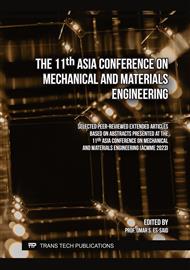[1]
S. G. Moghadam, H. Parsimehr, and A. Ehsani, "Multifunctional superhydrophobic surfaces," Adv. Colloid Inter. Sci. vol. 290, p.102397, April 2021.
DOI: 10.1016/j.cis.2021.102397
Google Scholar
[2]
Y. He, L. Wang, T. Wu, Z. Wu, Y. Chen, and K. Yin, "Facile fabrication of hierarchical textures for substrate-independent and durable superhydrophobic surfaces," Nanoscale vol. 14, pp.9392-9400, June 2022.
DOI: 10.1039/d2nr02157a
Google Scholar
[3]
S. Xiang and W. Liu, "Self-healing superhydrophobic surfaces: healing principles and applications, " Adv. Mater. Inter. vol. 8, p.2100247, 2021.
DOI: 10.1002/admi.202100247
Google Scholar
[4]
M. Z. Khan, J. Militky, M. Petru, B. Tomkova, A. Ali, E. Toren, and S. Perveen, "Recent advances in superhydrophobic surfaces for practical applications: A review, " Eur. Polym. J. vol. 178, p.111481, September 2022.
DOI: 10.1016/j.eurpolymj.2022.111481
Google Scholar
[5]
T. Young, "An essay on the cohesion of fluids," Phil. Tran. Roy. Soc. London, vol. 95, pp.65-87, 1805.
Google Scholar
[6]
M. D. L. Balela, R. A. Acedera, C. L. I. Flores, and C. M. O. Pelicano, "Surface modificationof ZnO nanostructured film prepard by hot water oxidation, " Surf. Coatings Tech. vol. 340, pp.199-209, April 2018.
DOI: 10.1016/j.surfcoat.2018.02.055
Google Scholar
[7]
A. Kołodziejczak-Radzimska and T.l Jesionowski, "Zinc Oxide – From synthesis to application: A review," Mater. vol 7, pp.2833-2881, 2014.
DOI: 10.3390/ma7042833
Google Scholar
[8]
M. D. L. Balela, C. M. O. Pelicano, and Z. Lockman, "In situ mixed potential study of the growth of zinc oxide hierarchical nanostructures by wet oxidation of zinc foil, " J. Mater. Sci. vol. 52, pp.2319-2328, February 2018.
DOI: 10.1007/s10853-016-0524-1
Google Scholar
[9]
L. Kumar, M. Rohit, P. Sen, and S. Annapoorni,"Processing temperature driven morphological evolution of ZnO nanostructures prepared by electro-exploding wire technique," Mater. Res. Exp. vol. 1, pp. p.015045, 2014.
DOI: 10.1088/2053-1591/1/1/015045
Google Scholar
[10]
W. H. Goo, L. H. Bac, E. J. Park, J. S. Kim, J. C. Kim, H. S Jung, and H. D. Lee, "Synthesis and characterization of nano-sized zn powder by electrical explosion of wire in liquid," Mod. Phys. Lett. B vol. 23, pp.3903-3909, 2009.
DOI: 10.1142/s0217984909021983
Google Scholar
[11]
N. Kamal Singh, A. Alqudami, S. Annapoorni, "ZnO nanoparticles prepared by electro-exploding wire technique," Phys. Status Solidi A vol. 207, pp.2153-2158, (2010)
DOI: 10.1002/pssa.200925553
Google Scholar



